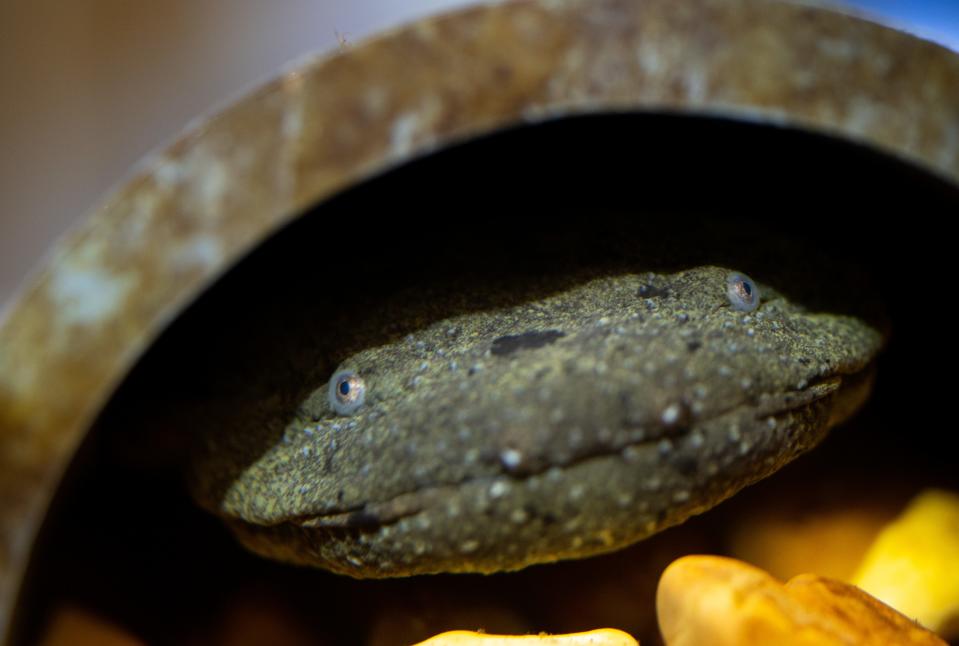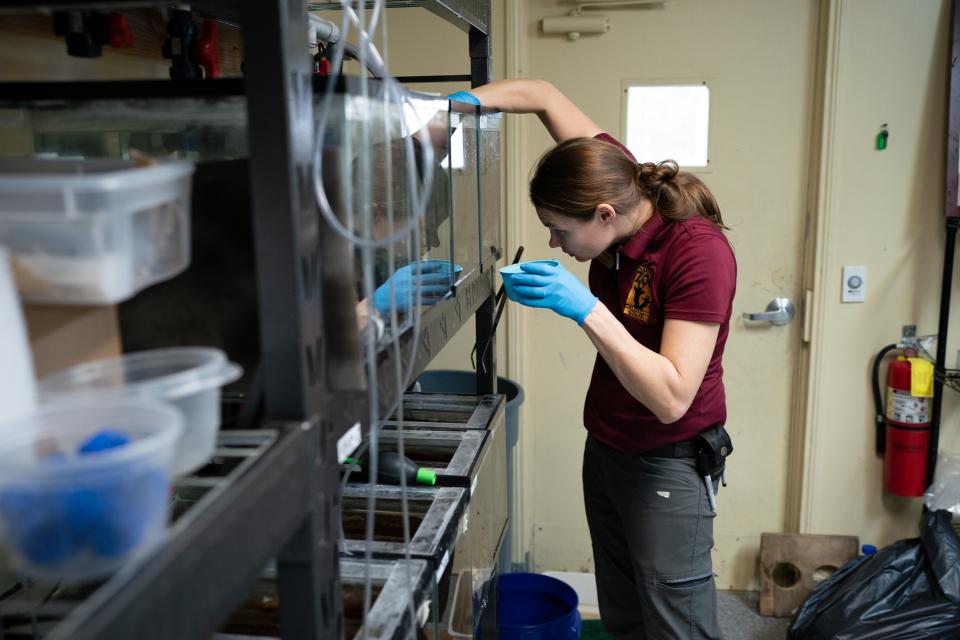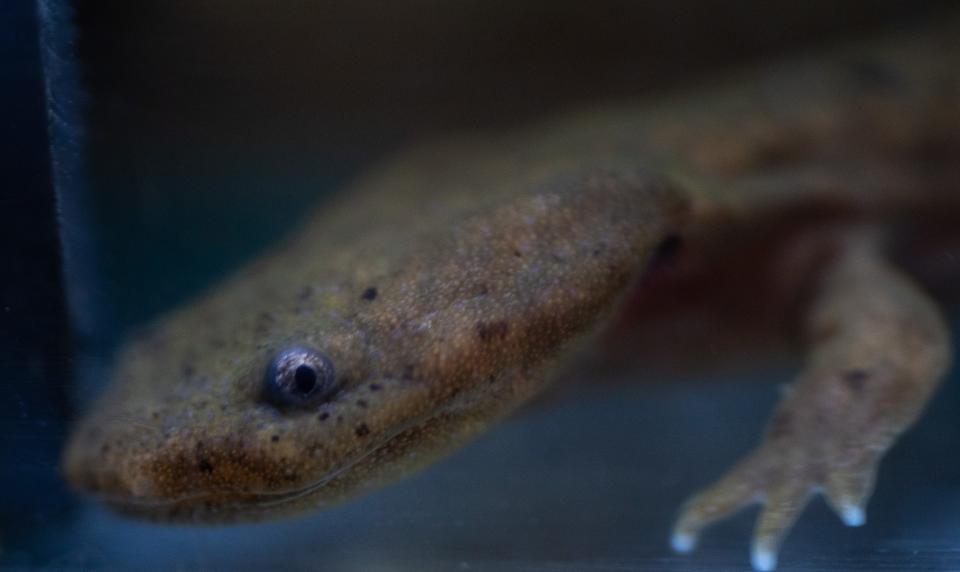Hellbent on conservation: How Nashville Zoo and state are preserving salamanders, mussels
From the madtom catfish to the oyster mussel, more than 130 aquatic species have made the federal list of endangered species, with several calling Tennessee waterways home.
And while the process to save such species from extinction can be rigorous and involved, the process by which a species becomes labeled as endangered is also a strenuous one, according to Josh Campbell, biodiversity chief at the Tennessee Wildlife Resource Agency.
"Once a species is proposed for listing, the fish and wildlife services assesses a lot of biological information about the species to determine if it's possibly a candidate for listing," Campbell said, noting that part of the process involves collecting data day-to-day.
There's also a review process that contains more detailed steps to determine whether a species makes the endangered list.
Daily work on endangered species

Whether the U.S. Fish and Wildlife Service is attempting to rejuvenate a species to protect it from the endangered species list or is actually placing it on the list, Campbell said the work is made possible through an endangered species fund that supports daily work.
When it is determined that a species should be placed on the endangered list, an action plan to recover that species is implemented, Campbell said. The goal is to meet as many action plans as possible to ensure recovery.
Campbell said one such plan for the Indiana gray bat involves protecting its summer roost sites, where noise and other disturbances have caused young bats to fly away too early or fall to their deaths, while other bats have expended too much energy during hibernation and starved to death trying to block out the noise.
When caves are fenced or gated off, Campbell said, they are done so for the protection of bats.
Some might ask, why do bats matter?

"The simple answer that I've heard some employees give is Mother Nature had it all balanced," Campbell said.
It's all about a balanced food chain, he explains, and when species are removed from that chain, others can be starved or slighted, especially in the case of aquatic species, which serve additional functions in preserving the cleanliness of drinking water in Tennessee.
Will it snow in Tennessee this winter? These signs of nature might tell you what to expect
"A lot of these species provide a high level of ecosystem services that we benefit from, like with bats and insect removal," said Chris Simpson, assistant chief of biodiversity at the Tennessee Wildlife Resource Agency.
Bats, he explained, forage nightly for food and can eat their body weight in insects, which helps farmers reduce pesticide use to protect their crops and impacts the cost of food, in addition to preventing pesky mosquito bites.
Water quality in Tennessee is aided by endangered mussels, which act as filters for waterways, removing sediment and impurities from water.
Tennessee is the most biodiverse inland state in the country, taking on a number of different species in a variety of ecosystems and habitats that range in elevation, Simpson said.
Nashville Zoo preserving wildlife
In addition to employing dedicated biologists who work daily to track different species as part of its $700,000 annual conservation budget, the Nashville Zoo is trying to actively remove certain Tennessee-based species from the endangered list. The two most-targeted species at the zoo have been hellbender salamanders and Nashville crayfish.

The eastern hellbender head-start program has been the zoo's most in-depth conservation project to date, according to zoo spokesperson Mallory Immel.
In May, the Nashville Zoo released 24 hellbender salamanders back into the wild. It was the third such group to be released.
"We recognized a need for a head-start program due to researchers noticing a decline in their population over the past few decades," Immel said. "Head-starting is a strategy that focuses on raising at-risk animals in human care to then be released back into their native habitat in an effort to sustain wild populations."
The zoo's ectotherm team released the salamanders through a partnership with TWRA and Tennessee State University.
Daylight saving time : When does the time change in Tennessee?
TWRA used state wildlife grants totaling $145,000 to fund the five-year salamander project, which began in 2020.
Work is also continuing with the Nashville crayfish, which is the only animal whose entire range is located in the greater Nashville area. They are found in Mill Creek and its tributaries, which flow through Nashville Zoo.
TWRA is using endangered species grant funds totaling $55,000 over five years to support crayfish within the Mill Creek watershed.
Due to pollution and agricultural run-off, the species is endangered.
In the spring, the zoo's aquatics team recorded more than 400 crayfish at four different locations, all of which are monitored four times each year to assess the population.
The crayfish is a food source for more than 240 species, including fish, racoons and reptiles, making it an important part of the ecosystem, wildlife officials note.
Preserving the population and growing it can be achieved by keeping waterways clean from trash and other pollution and ensuring no exposed soil pesticides and pollutants are left on the ground, since they can deposit storm water into nearby creeks, they said.
Reach reporter Craig Shoup by email at cshoup@gannett.com and on X, the platform formerly known as Twitter, @Craig_Shoup. To support his work, sign up for a digital subscription to www.tennessean.com.
This article originally appeared on Nashville Tennessean: Tennessee, Nashville Zoo work together to help endangered species

